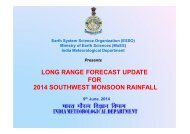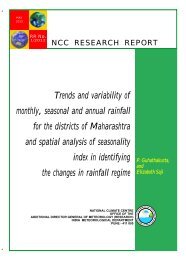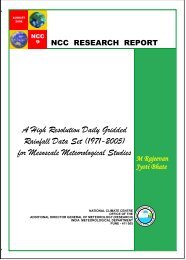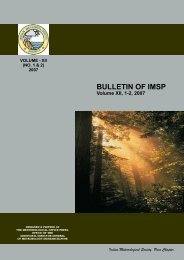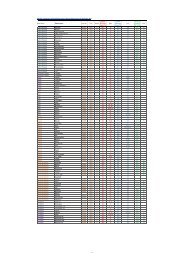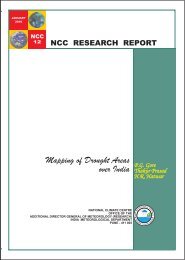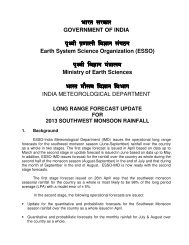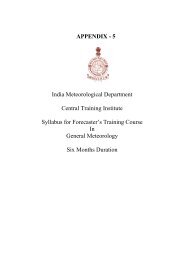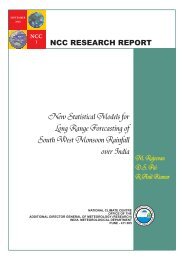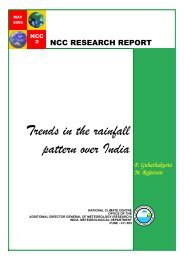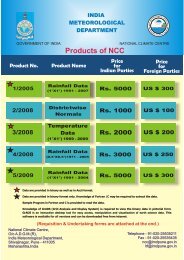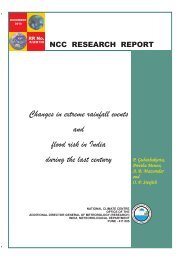Trends in Precipitation Extremes over India - (IMD), Pune
Trends in Precipitation Extremes over India - (IMD), Pune
Trends in Precipitation Extremes over India - (IMD), Pune
Create successful ePaper yourself
Turn your PDF publications into a flip-book with our unique Google optimized e-Paper software.
1. IntroductionAbout 60-90% of the annual ra<strong>in</strong>fall <strong>over</strong> <strong>India</strong> is received dur<strong>in</strong>g thesouthwest monsoon season (June to September), which is vital for the economy ofthe country. Inter-annual variation of seasonal and annual ra<strong>in</strong>fall is a subject formore serious research work <strong>in</strong> <strong>India</strong>. However, <strong>in</strong>formation about the long termtrends of ra<strong>in</strong>fall is also important. Previous studies have addressed the issue ofchanges <strong>in</strong> the mean ra<strong>in</strong>fall. For example, Guhathakurta and Rajeevan (2006) haveshown that there is no long term trend <strong>in</strong> the southwest monsoon seasonal ra<strong>in</strong>fall<strong>over</strong> the country as a whole, but there are significant regional variations. However,changes <strong>in</strong> extreme precipitation are also equally important to <strong>in</strong>vestigate. Impact ofclimate changes are felt most strongly through changes <strong>in</strong> climate extremes. Anypositive or <strong>in</strong>creas<strong>in</strong>g trend <strong>in</strong> the extreme ra<strong>in</strong>fall events is also a serious concern.The recent extreme heavy ra<strong>in</strong>fall event occurred <strong>over</strong> Mumbai on 26 th July 2005prompts us to th<strong>in</strong>k whether there is any significant trend <strong>in</strong> extreme ra<strong>in</strong>fall events<strong>over</strong> different parts of <strong>India</strong>.One of the most significant consequences of global warm<strong>in</strong>g due to <strong>in</strong>crease<strong>in</strong> greenhouse gases would be an <strong>in</strong>crease <strong>in</strong> magnitude and frequency of extremeprecipitation events. These <strong>in</strong>creased extreme precipitation events can be attributedto <strong>in</strong>crease <strong>in</strong> moisture levels, thunderstorm activities and large scale storm activity.In the global warm<strong>in</strong>g scenario, climate models generally predict an <strong>in</strong>crease <strong>in</strong> largeprecipitation events (Houghton et al 2001). The numerical modell<strong>in</strong>g community anddata analysts have shown <strong>in</strong>terest on the issue of extreme events occurr<strong>in</strong>g aroundthe world.The recent studies have shown that there is an <strong>in</strong>creas<strong>in</strong>g trend of extremeprecipitation events <strong>in</strong> USA and Australia (Easterl<strong>in</strong>g et al. 2000, Haylock andNicholls 2000, Groisman et al. 2001; Kunkel 2003), western New Zealand(Sal<strong>in</strong>gerand Griffiths 2001), the UK <strong>in</strong> w<strong>in</strong>ter (Osborn et al. 2000), and south Africa(Fauchereau et al. 2003). Extreme ra<strong>in</strong>fall events <strong>in</strong> Canada show no trend (Zhang2



